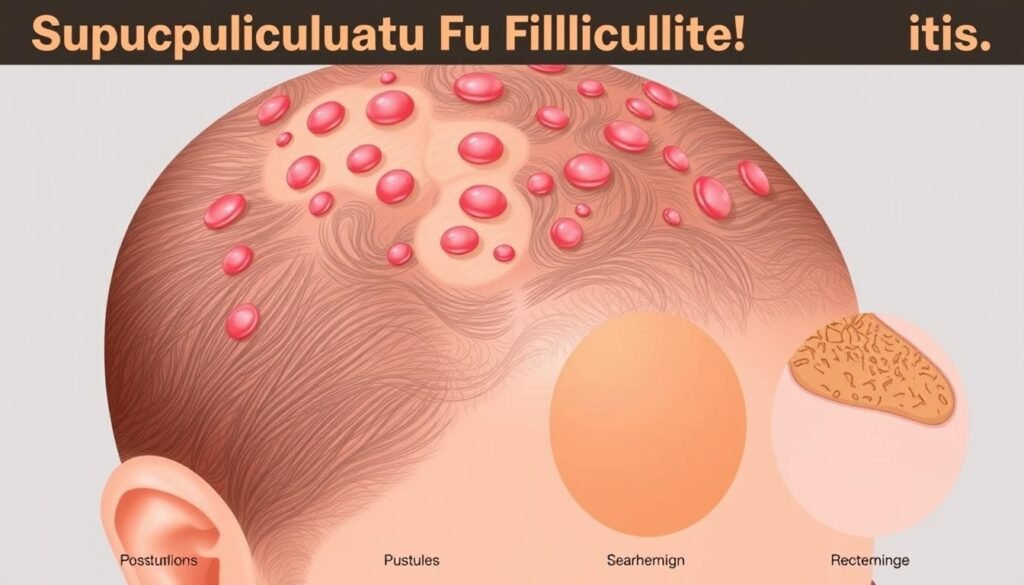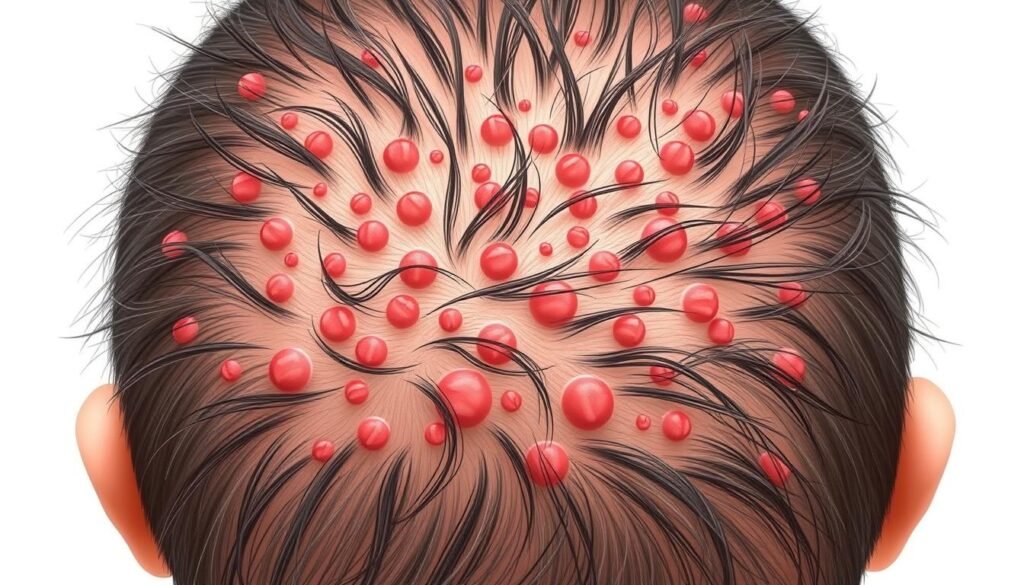Superficial folliculitis is a common scalp infection. It’s mostly caused by *Staphylococcus aureus* bacteria. These bacteria are generally harmless but can cause problems when they enter hair follicles. This leads to swollen hair follicles, itchy bumps, and sores filled with pus. Without treatment, this condition can get worse. It might cause more severe infections. This can lead to embarrassment, discomfort, and even long-term problems.
To manage and prevent superficial folliculitis, it’s important to understand it. Know its causes, symptoms, and how to treat it. For more information on this skin condition, visit reliable medical resources.
Key Takeaways
- Superficial folliculitis is often caused by the bacteria Staphylococcus aureus.
- The condition manifests as itchy bumps and pus-filled sores on the scalp.
- Effective management and treatment options are crucial to prevent complications.
- Improper hygiene and wearing tight clothing can increase the risk of developing folliculitis.
- Staying informed about underlying health conditions can help mitigate symptoms.
Understanding Superficial Folliculitis
Superficial folliculitis is a condition where the top of hair follicles get inflamed. It often happens on the scalp and hairy areas. It can cause small, red, itchy or painful bumps. Usually, it’s not serious, but comes from different things like bacteria or certain triggers.
This issue can come from a bacteria called Pseudomonas aeruginosa. This happens in warm, untreated spa water. Another cause is a yeast called Pityrosporum ovale, which is also known to cause trouble. Even physical irritation can trigger its symptoms.
For milder cases, taking care of yourself at home can help. Things like warm compresses and antibacterial soaps can ease the symptoms. But, if it keeps coming back or gets worse, seeing a doctor might be needed. It’s key to know how to handle it. Learn more about it by checking a comprehensive overview on folliculitis for proper care.
The Symptoms of Superficial Folliculitis
Finding the symptoms of folliculitis early is key. It hits the hair follicles and shows up in easy-to-spot signs. Knowing these symptoms helps people get to a doctor fast.
Clusters of Small Bumps
One key symptom is the sight of small bump clusters. These look like itchy red bumps near hair follicles. They turn red and swollen, showing something’s not right. Catching these early improves the chances of getting better.
Pus-filled Blisters
Later on, pus-filled blisters might form. If they pop, crusty sores can appear on the skin. It’s crucial to watch these blisters. They mean the infection’s getting worse, and you might need more help from a doctor.
Itchy and Tender Skin
Often, people feel itchy and tender skin where it’s affected. This itchiness can be really bothersome, making people want to scratch. Stopping this itch is important to avoid worse problems and help the skin heal.
Causes of Superficial Folliculitis
Folliculitis is common but can be managed by understanding its causes. Bacterial infections, particularly from Staphylococcus aureus, are mainly to blame. These bacteria get into hair follicles through small skin injuries, leading to swollen spots. Other non-infectious elements also play a big part in causing folliculitis.
Bacterial Infections
Bacteria, especially Staphylococcus aureus, are key in causing this skin issue. They infect hair follicles, causing pain and redness. If not treated, these small bumps can turn into sores filled with pus.
Non-infectious Factors
Tight clothing and strong sweating can cause irritation around hair roots. Shaving or waxing can also make the skin angry, causing folliculitis. Some drugs make the situation worse, especially for those already dealing with skin problems.
| Cause | Description |
|---|---|
| Bacterial Infection | Primarily caused by Staphylococcus aureus, leading to red bumps and possible pus. |
| Tight Clothing | Increases friction and sweat, which can irritate hair follicles. |
| Skin Irritants | Certain shampoos and hair products can cause inflammation and folliculitis. |
| Proper Shaving Techniques | Shaving against hair growth can lead to mechanical folliculitis. |
| Drug-Related Causes | Medications like corticosteroids may precipitate folliculitis in susceptible individuals. |
Risk Factors for Developing Folliculitis
Knowing what makes folliculitis more likely can help you avoid it. There are many reasons why someone might get this skin problem. Being aware helps you improve cleanliness and change some habits.
Wearing Tight Clothing
Close-fitting clothes can trap moisture and rub the skin. This makes it easy for hair follicles to get infected. Such conditions are worse where clothes press directly on the skin.
Improper Hygiene Practices
Keeping skin clean is very important. Not bathing enough or sharing things like razors can raise your folliculitis risk. Wash regularly to clear sweat, dirt, and germs that might infect hair roots.
Long-term Use of Antibiotics
Long antibiotic use can harm your skin’s good bacteria. This can let bad bacteria grow and might cause folliculitis. It’s important to think carefully if you need antibiotics for a long time.

| Risk Factor | Impact on Folliculitis |
|---|---|
| Tight Clothing | Increases irritation and moisture retention |
| Improper Hygiene Practices | Facilitates bacterial growth and infection |
| Long-term Antibiotic Use | Can disrupt normal skin flora, leading to infections |
Types of Folliculitis and Their Distinctions
Various types of folliculitis show different signs and causes. Bacterial folliculitis is one of the most common types. It’s caused mainly by Staphylococcus aureus. This kind usually appears as small, red bumps or blisters filled with pus. You can see them on the scalp and other parts of the body.
Hot tub rash is another usual type, linked to Pseudomonas aeruginosa. This germ spreads in poorly treated hot tubs or pools. The rash looks like itchy, red skin and often is under swimsuits.
There’s also pseudofolliculitis barbae, from ingrown hairs. It happens a lot to those who shave often. This type mainly affects the beard area. Pityrosporum folliculitis is tied to fungal infections. It’s more common among young adults with oily skin.
Last is eosinophilic folliculitis, affecting people with weaker immune systems. It shows as groups of sore hair follicles and causes severe itching. Knowing these types helps doctors pinpoint the right diagnosis and treatment.
| Type of Folliculitis | Cause | Common Symptoms | Typical Treatment |
|---|---|---|---|
| Bacterial Folliculitis | Staphylococcus aureus | Red bumps, pus-filled blisters | Topical or oral antibiotics |
| Hot Tub Rash | Pseudomonas aeruginosa | Itchy, red rash | Skin care and antiseptic agents |
| Pseudofolliculitis Barbae | Ingrown hairs | Red bumps in beard area | Improved shaving techniques |
| Pityrosporum Folliculitis | Fungal infection | Red pustules on the chest and back | Topical antifungal treatments |
| Eosinophilic Folliculitis | Immune deficiency | Inflamed follicles, itching | Corticosteroids and antihistamines |
Diagnosis of Superficial Folliculitis
Diagnosing folliculitis starts with noticing symptoms recognition. You might see red bumps or pus-filled blisters on your skin. These signs usually group together. It’s easy to spot them. Knowing these symptoms helps to treat it early.
Recognizing the Symptoms
If you see symptoms, check your skin closely. Look for red, swollen spots or feel for itchiness. Catching these signs early helps a lot in treating the condition.
Medical Examination
Getting a complete check-up is crucial for diagnosing superficial folliculitis. A doctor will look carefully at your skin, especially where hair grows. Sometimes, they might need to do extra tests, like taking a small skin sample.
This step is key to tell superficial folliculitis apart from other skin issues.

Treatment Options for Superficial Folliculitis
Treatments for folliculitis are key to easing symptoms and avoiding complications. They vary based on the infection’s severity and type. Over-the-counter options provide relief for many with mild cases. When the infection lingers, prescription medicines may be needed.
Over-the-Counter Treatments
For mild superficial folliculitis, there are many over-the-counter treatments. Topical antibiotics, like bacitracin or neomycin, can fight bacterial infections. Medicated shampoos with salicylic acid or ketoconazole are helpful, too. Washing the affected areas with gentle cleansers can aid healing and lessen irritation.
Prescription Medications
If over-the-counter remedies don’t work, doctors may prescribe stronger antibiotics. Mild bacterial infections respond well to antibiotic lotions or gels. Oral antibiotics are for tougher cases. Antifungal medications treat yeast-caused folliculitis. Steroid creams can ease inflammation.
Home Remedies
Home remedies also support superficial folliculitis management. Warm compresses on the skin can reduce pain and help heal. Keeping clean is crucial; gentle soaps avoid more irritation. Lotions and self-care can ease symptoms without heavy medical treatments.
| Treatment Type | Examples | Indications |
|---|---|---|
| Over-the-Counter Solutions | Topical antibiotics, medicated shampoos | Mild infections |
| Prescription Medications | Oral antibiotics, antifungal creams, steroid creams | Moderate to severe infections |
| Home Remedies | Warm compresses, gentle cleansers, soothing lotions | Symptom relief and hygiene maintenance |
Complications Related to Untreated Folliculitis
If folliculitis isn’t treated, it can cause serious problems for your skin’s health. People might face permanent hair loss and scarring. These issues highlight why treating folliculitis early is crucial.
Permanent Hair Loss
Permanent hair loss is a severe complication of folliculitis. Damage from ongoing infection can stop hair from growing. This leaves bald spots or thin areas on the head. Losing hair can hurt someone’s self-esteem and lead to emotional stress.
Scarring and Skin Changes
Untreated folliculitis can also cause scarring. The skin’s texture might change, resulting in scarring, dark or light spots. These skin changes can become worse over time. They make the skin look uneven and affect how a person looks.
Not dealing with folliculitis can lead to worse infections. These may need a lot of medical care. To learn more about these risks, check out medical resources.

Preventing Superficial Folliculitis
To stop folliculitis, focus on cleanliness and less skin irritation. This hair follicle inflammation is avoidable with simple skin care and reducing rubbing.
Proper Hygiene Practices
Cleaning skin with soft soap helps stop this condition. It prevents germs from causing infection. Also, sanitize razors and towels often. Using antibacterial soap boosts cleanliness and fights bacterial infections. Washing your skin regularly also lessens irritation and outbreaks.
Avoiding Irritation and Friction
Wearing loose clothes helps reduce skin friction. This is important during physical activities to avoid heat and sweat build-up. Tight clothes can irritate your skin, raising the chance of getting folliculitis. Also, shaving correctly prevents ingrown hairs which can cause this condition. Try to stay cool and avoid too much sweat after hard work outs.
Conclusion
Superficial folliculitis is common and is usually caused by bacteria like Staphylococcus aureus. It causes inflammation in the hair follicles. Recognizing the signs, reasons, and possible outcomes of this condition is key to dealing with it.
It often gets better on its own in a few days. However, some types may come back or stay longer.
There are different ways to treat it, including items you can buy without a prescription and stronger drugs from a doctor. Getting help early can lead to a good recovery. This lets people tackle their scalp issues effectively. For deeper insights, check out the summary of folliculitis.
Preventing it is also key. Good hygiene and skin care can lower the risk of getting it again. Skin infections are on the rise. Knowing how to spot and handle them can greatly enhance skin health. Stay educated to keep your scalp in good shape.
